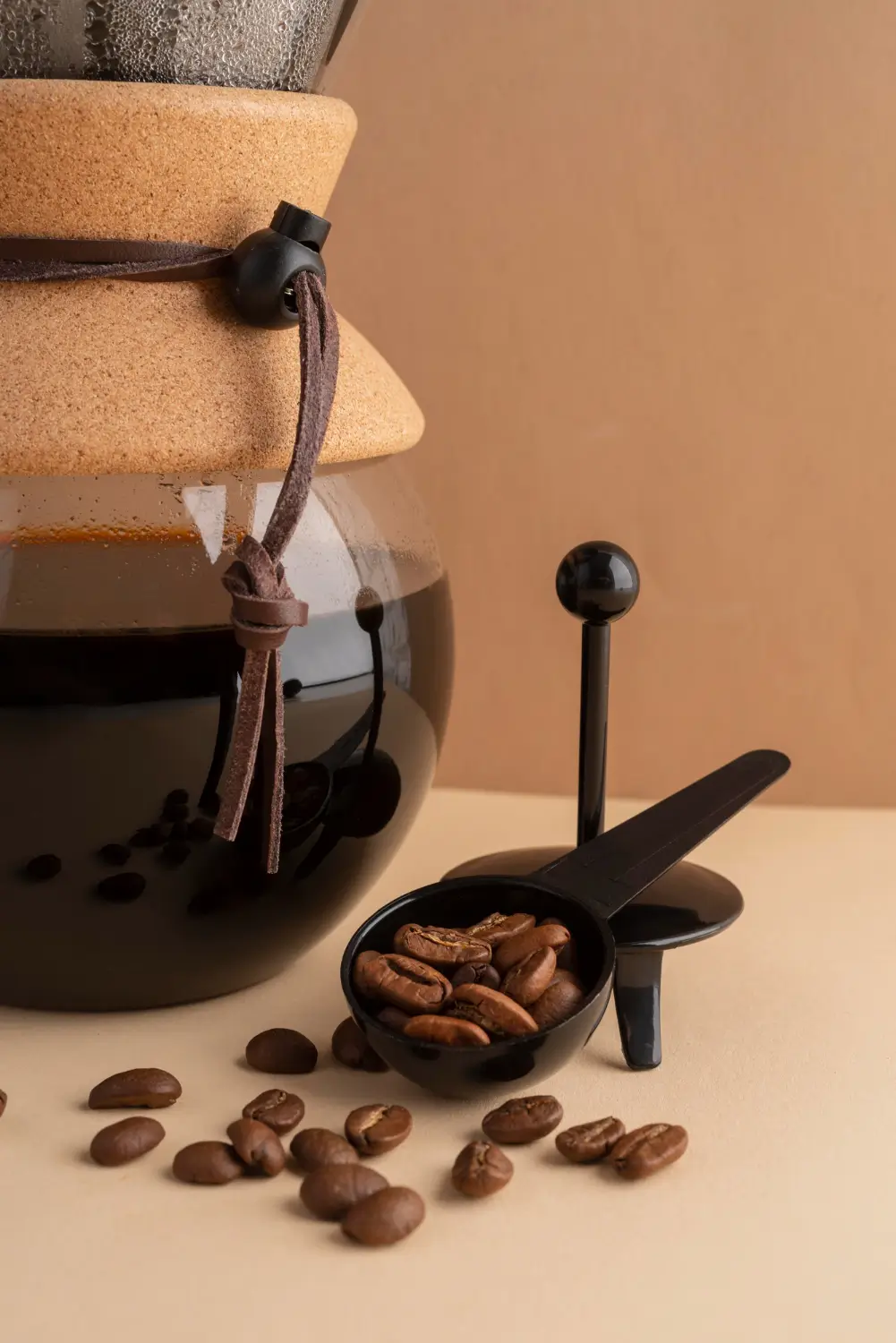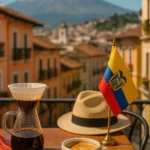You know Arabica coffee. It often gets all the glory. But there’s another coffee bean, Robusta, that plays a huge role in your daily brew. This tough, powerful bean makes up a big part of global coffee production. It’s everywhere, in many of the coffees you drink.
You will discover Robusta’s special qualities in this article. We’ll look at where it grows, what it’s used for, and its impact on the world. Learning about Robusta coffee helps you truly understand the wide world of coffee. It adds a unique taste to countless cups globally.
What is Robusta coffee?
Robusta coffee, known scientifically as Coffea canephora var. robusta, is a major coffee species. It’s a hardy plant, strong and packed with caffeine. It has much more caffeine than Arabica. Robusta beans deliver bolder, more intense flavors. You’ll find them in espresso blends and instant coffee.
What makes Robusta coffee unique?
Robusta coffee has distinct traits. Its physical makeup and chemical content set it apart. These qualities give Robusta its place in the coffee market. Knowing these traits shows you why it’s so useful and tastes so strong.
Plant characteristics
The Robusta coffee plant is incredibly resilient. It adapts well to its environment. This plant is hardier than Arabica. It grows easily in tougher conditions. You find it thriving at lower elevations, handling tropical and subtropical weather. It can grow up to 10 meters (30 feet) tall, but its roots stay shallow.
Bean appearance
Robusta coffee beans look different from Arabica beans. Robusta beans are smaller and rounder. Their shape is often less uniform than Arabica’s oval form. They have a thicker outer layer, often smooth. You’ll notice a distinct crease on one side. The base often shows a heart shape. Their color, when ripe, can vary from greenish-brown depending on how they’re processed.
Chemical composition
The chemistry inside Robusta beans shows their power. Robusta beans have about twice the caffeine of Arabica beans. They also contain more chlorogenic acid, an antioxidant. These beans have less sugar and fat—about 60% less than Arabica. This makeup gives Robusta its bold, strong taste.
Flavor profile
Robusta coffee has a well-known flavor. It’s strong and bold. You might describe it as earthy, woodsy, or nutty—like peanuts. It can also taste chocolatey, caramel, smoky, or spicy. Robusta’s taste changes a lot with how you roast it. This gives you many different taste experiences.
- Light roast: Expect a lighter body with a bitter taste. You’ll find subtle chocolate and nutty notes.
- Medium roast: This roast gives a strong earthy flavor. It brings out hints of chocolate, nut, and smoke, with low acidity.
- Dark roast: You get an intense, bold, smoky, bitter taste. This roast creates a fuller body and strong dark cocoa notes.
Where and how Robusta coffee grows
Robusta coffee grows in many places. It adapts well to different regions. Farmers worldwide grow Robusta. It’s a common part of the global coffee market. Its toughness lets it grow where other coffee types struggle.
Primary cultivation regions
Robusta coffee grows mostly in certain countries. Vietnam is the top producer, making over 40% of the world’s supply. Other big producers are Brazil, Indonesia, India, Uganda, and West African countries like Ivory Coast and Cameroon. This shows how widely Robusta grows across Southeast Asia, Africa, and South America.
Ideal growing conditions
Robusta coffee needs certain conditions to grow well. This makes it a tough crop. It prefers:
- Warm, humid, equatorial or tropical climates.
- Temperatures between 20°C and 30°C.
- Low elevations, from 0 to 800 meters.
- Full sunshine and intense heat.
- Plenty of rainfall.
- Diverse soil types, often alongside crops like cocoa and bananas.
The Robusta plant takes 10–11 months to mature slowly. It also fights off diseases, like coffee leaf rust, and pests better than other coffees. This makes it hardier.
How Robusta coffee compares to Arabica
Robusta and Arabica are the two main coffee types. Each has its own distinct traits. They differ in how they grow, how they taste, their caffeine levels, and how the market uses them. Knowing these differences shows how they work together in the coffee world.
Robusta Coffee vs Arabica
| Feature | Robusta Coffee | Arabica Coffee |
|---|---|---|
| Cultivation | Easier to grow, faster growing, thrives in harsher climates, resists pests and diseases. | Harder to grow, sensitive to environment and diseases, needs careful cultivation. |
| Taste | Bitter, harsh, earthy, peanut-like, oatmeal-like, dark chocolate aftertaste, low acidity, full-bodied. | Smooth, sweet, fruity, wine-like, complex nuances, higher acidity. |
| Caffeine Content | 2.2% to 2.7% by weight (about double Arabica). | 1.2% to 1.5% by weight. |
| Market Use | Instant coffee, espresso blends, affordable coffee products; quality is improving. | Specialty and premium coffee market. |
Cultivation differences
Robusta coffee is easier to grow than Arabica. The Robusta plant grows faster. It thrives in tougher climates. It also fights off pests and diseases better. This makes it a more reliable crop for farmers. Arabica coffee needs more careful care. It is sensitive to environmental changes and plant diseases.
Taste and acidity differences
Robusta and Arabica coffees taste very different. Arabica coffee is smooth and sweet. It often tastes fruity or wine-like. It has higher acidity and complex notes. Robusta coffee, on the other hand, tastes more bitter, harsher, and earthy. People often describe it as peanut-like or oatmeal-like. It can leave a distinct peanut or dark chocolate aftertaste. Its lower acidity makes it less bright and gives it a fuller body.
Caffeine content difference
Robusta beans have much more caffeine than Arabica beans. Robusta typically has 2.2% to 2.7% caffeine by weight. That’s about double the 1.2% to 1.5% in Arabica. This higher caffeine level makes Robusta taste bitter. It also helps the plant repel pests.
Market use and perception differences
How the market uses Robusta coffee differs from Arabica. Arabica coffee leads the specialty and premium markets. Coffee lovers prefer its complex flavors. Robusta coffee appears in instant coffee, espresso blends, and cheaper coffee products. It’s cost-effective and has a strong flavor. People used to see Robusta as low-quality. But its quality is getting better. Farmers and roasters are making better Robusta. This is changing how people see it.
What are the common uses of Robusta coffee?
Robusta coffee has many uses in the coffee industry. Its bold flavor, high caffeine, and lower cost make it versatile. These traits make Robusta a key part of many popular coffee products worldwide.
Why Robusta coffee is in espresso blends
Robusta coffee is perfect for espresso blends. It adds important qualities to your shot. It gives a lot of boldness and a bigger caffeine kick. Most importantly, Robusta helps create that rich, reddish-brown crema you want on a good espresso. This makes your espresso fuller bodied and more intense. Many Italian espresso recipes use some Robusta. This helps get the perfect crema and punch.
Why Robusta coffee is popular for instant coffee
Robusta coffee is widely used for instant coffee. It offers several benefits. It’s affordable. It has high caffeine. Its flavor works well for large-scale production. Manufacturers use spray-drying and freeze-drying. These turn brewed coffee into soluble granules. Robusta’s strong taste ensures the instant product still tastes like coffee.
How Robusta coffee is used in general coffee blends
Robusta coffee plays a role in many coffee blends. It can act as a filler or make the flavor stronger. Adding Robusta helps make coffee products cheaper for you. It also fits tastes that prefer a bolder, stronger brew. Many average ground coffee blends include Robusta. This helps them get a consistent body and intensity.
Which commercial brands use Robusta coffee?
Many popular commercial brands use Robusta coffee. They like its qualities. Global brands like Lavazza, Nescafe, Illy, and Nestlé often put Robusta in their blends and instant coffees. Top Southeast Asian brands like Trung Nguyen, G7 Coffee, Café Amazon, and Kapal Api also use a lot of Robusta. These brands use Robusta’s bold flavor and cost benefits. They meet different customer demands around the world.
What is Robusta coffee’s global economic impact?
Robusta coffee has a deep global economic impact. It’s more than just a drink. It’s a big part of international trade. It supports millions of people’s lives. Its resilience and wide growth help the global coffee market a lot.
Market share and key producers
Robusta coffee makes up about 30–40% of all coffee produced worldwide. That’s a big share. Vietnam is the largest producer. It accounts for over 40% of all Robusta output. Other main producers are Brazil, Indonesia, Uganda, and India. Together with Vietnam, these countries produce over 90% of the world’s Robusta coffee. These nations are key in supplying Robusta beans to the global market.
Economic importance and livelihoods
Robusta coffee has huge economic importance. It helps millions of small farmers in producing countries. Growing it adds a lot to national export revenues. For example, Ivory Coast greatly boosted its economy by growing more Robusta in the mid-20th century. The Robusta plant is cost-effective. It also withstands climate change well. This makes it a steady income source for many farming communities. This resilience is a big plus in today’s changing climate.
Market growth and projections
The Robusta coffee market is growing fast. It looks good for the next few years. In 2022, its value was around USD 18.16 billion. By 2030, it could reach USD 28.73 billion. This is a growth rate of about 5.9% each year. People are drinking more coffee globally. Robusta also has new uses in medicine, food, and personal care products. These drive the growth. Plus, more people want specialty Robusta. This also helps its market grow.
Robusta coffee, often less noticed than Arabica, is a cornerstone of the global coffee business. Its toughness, bold flavor, and high caffeine make it vital. It’s in everything from rich espresso to quick instant coffee. Robusta supports huge economies. It provides income for millions of small farmers. It also offers a resilient crop option as the climate changes. As Robusta’s quality improves and people’s views shift, it will keep its important place in the coffee world.









